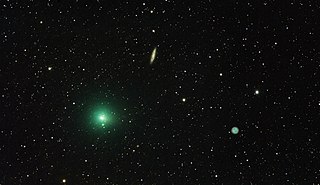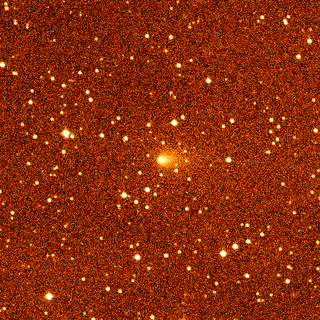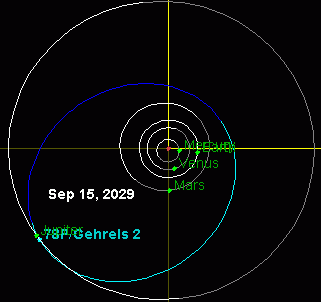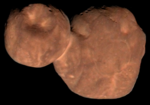
Comet 4P/Faye is a periodic Jupiter-family comet discovered in November 1843 by Hervé Faye at the Royal Observatory in Paris. Its most recent perihelia were on November 15, 2006; May 29, 2014; and September 8, 2021.

41P/Tuttle–Giacobini–Kresák is a periodic comet in the Solar System. The comet nucleus is estimated to be 1.4 kilometers in diameter.

48P/Johnson is a periodic comet in the Solar System.

49P/Arend–Rigaux is a periodic comet in the Solar System.

52P/Harrington–Abell is a periodic comet in the Solar System.

60P/Tsuchinshan, also known as Tsuchinshan 2, is a periodic comet in the Solar System with an orbital period of 6.79 years. Tsuchinshan is the Wade-Giles transliteration corresponding to the pinyin Zǐjīn Shān 紫金山, which is Mandarin Chinese for "Purple Mountain".

74P/Smirnova–Chernykh is a periodic comet in the Solar System. It fits the definition of an Encke-type comet with, and is a Quasi-Hilda comet. It was discovered in late March 1975 by Tamara Mikhajlovna Smirnova while examining exposures from the Crimean Astrophysical Observatory. In the discovery images the comet had an apparent magnitude of ~15. In the year of discovery, the comet came to perihelion on August 6, 1975.
98P/Takamizawa is a periodic comet in the Solar System.
111P/Helin–Roman–Crockett is a periodic comet in the Solar System. It was discovered by Eleanor and Ron Helin, Brian Roman and Randy Crockett on 5 January 1989 from images obtained on the 3rd and 4th of that month. It is a Jupiter family comet known for extremely close approaches to Jupiter being a Quasi-Hilda comet. During these approaches, it actually orbits Jupiter. The last such approach was in 1976, the next will be in 2071. The Jovian orbits are highly elliptical and subject to intense Solar perturbation at apojove which eventually pulls the comet out of Jovian orbit for the cycle to begin anew.

119P/Parker–Hartley is a periodic comet in the Solar System.
120P/Mueller, also known as Mueller 1, is a periodic comet in the Solar System. It last came to perihelion in May 2021 and underwent a 1.4 magnitude outburst in August 2021,.
138P/Shoemaker–Levy, also known as Shoemaker–Levy 7, is a faint periodic comet in the Solar System. The comet last came to perihelion on 11 June 2012, but only brightened to about apparent magnitude 20.5.
152P/Helin–Lawrence is a periodic comet in the Solar System.
158P/Kowal–LINEAR is a periodic comet in the Solar System that has an orbit out by Jupiter.

171P/Spahr is a periodic comet in the Solar System. 171P/Spahr was recovered on 20–24 October 2011 at apparent magnitude 20.6 using the 2.0-metre (79 in) Faulkes Telescope South. 171P/Spahr is peaked at about magnitude 18 in 2012.

118P/Shoemaker–Levy is a comet discovered by astronomers Carolyn and Eugene M. Shoemaker and David Levy.

Comet Kopff or 22P/Kopff is a periodic comet in the Solar System. Discovered on August 23, 1906, it was named after August Kopff who discovered the comet. The comet was missed on its November 1912 return, but was recovered on its June 1919 return and has been seen at every apparition since. Close approaches to Jupiter in 1938 and 1943 decreased the perihelion distance and orbital period. 22P/Kopff’s last perihelion passage was 18 March 2022. On 13 July 2028 it will pass 0.353 AU (52.8 million km) from Earth.

Comet 30P/Reinmuth, also known as Comet Reinmuth 1, is a periodic comet in the Solar System, first discovered by Karl Reinmuth on February 22, 1928.

144P/Kushida is a periodic comet discovered in January, 1994, by Yoshio Kushida at the Yatsugatake South Base Observatory in Japan. This was the first comet discovery of 1994 and his second discovery within a month. It last came to perihelion on 25 January 2024, and brightened to about magnitude 10.

62P/Tsuchinshan, also known as Tsuchinshan 1, is a periodic comet first discovered January 1, 1965 at the Purple Mountain Observatory in Nanking. It last came to perihelion on 25 December 2023 at around apparent magnitude 8, and was then 0.53 AU (79 million km) from Earth and 110 degrees from the Sun.




















